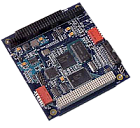 Model 314
MPEG-4/2/1 and MJPEG Frame Grabber
Model 314 is a low-cost MPEG-4/2/1 and MJPEG frame grabber that captures full-frame (720 x 480) video at 30 frames per second. Uncompressed video is available through the PC/104+ bus for previewing. It also has two synchronized audio input channels and on screen display of text (OSD).
Advantages of compression
MPEG and MJPEG data reduces the amount of memory required to store full motion video. The compressed data requires a smaller transmission bandwidth. MJPEG data is typically compressed by a factor 20 while MPEG-2 and -4 by a factor of 100. Image compression makes it possible to transmit 30 frames/sec of MPEG video over the PC/104+ bus. The hardware compression circuit uses a motion estimation algorithm to produce smooth images from interlaced cameras.
Uncompressed capture
The 314 can function as a conventional frame grabber by supplying uncompressed video with low latency and snapshots of single frames. A lower cost version, 314NC, is available without the compression circuitry and the on screen display. It uses the newest 9-bit digitizer technology plus an adaptive multi-line comb filter to produce higher quality images than those using BT878 technology.
On screen display
A 96 character buffer is available for adding text to each frame. The text is within a transparent box that may be positioned anywhere within the frame. This function is not available on the 314NC.
Motion detection
The 314 performs motion detection in three user programmable regions of interest. For each separate region of interest, the user can set up different motion detection sensitivity. Within the regions of interest motion can be further localized to a 16x16 pixel block. The following links show examples of the motion detection setup menu for Windows and the regions of interest. The motion map shows where the motion was detected. (Please see image under the tab: Images and Mechanical Drawings).
Audio multiplexing
Digitized audio from the 314 is multiplexed into MPEG streams by a Sensoray-supplied software in SDK. Hence, the 314 does perform A/V multiplexing as does model 516 and 616. External signals connect to the 314 via a 24-pin header. Sensoray’s optional 314TA video termination board provides BNC connections for the 314’s composite video inputs.
Model 314
MPEG-4/2/1 and MJPEG Frame Grabber
Model 314 is a low-cost MPEG-4/2/1 and MJPEG frame grabber that captures full-frame (720 x 480) video at 30 frames per second. Uncompressed video is available through the PC/104+ bus for previewing. It also has two synchronized audio input channels and on screen display of text (OSD).
Advantages of compression
MPEG and MJPEG data reduces the amount of memory required to store full motion video. The compressed data requires a smaller transmission bandwidth. MJPEG data is typically compressed by a factor 20 while MPEG-2 and -4 by a factor of 100. Image compression makes it possible to transmit 30 frames/sec of MPEG video over the PC/104+ bus. The hardware compression circuit uses a motion estimation algorithm to produce smooth images from interlaced cameras.
Uncompressed capture
The 314 can function as a conventional frame grabber by supplying uncompressed video with low latency and snapshots of single frames. A lower cost version, 314NC, is available without the compression circuitry and the on screen display. It uses the newest 9-bit digitizer technology plus an adaptive multi-line comb filter to produce higher quality images than those using BT878 technology.
On screen display
A 96 character buffer is available for adding text to each frame. The text is within a transparent box that may be positioned anywhere within the frame. This function is not available on the 314NC.
Motion detection
The 314 performs motion detection in three user programmable regions of interest. For each separate region of interest, the user can set up different motion detection sensitivity. Within the regions of interest motion can be further localized to a 16x16 pixel block. The following links show examples of the motion detection setup menu for Windows and the regions of interest. The motion map shows where the motion was detected. (Please see image under the tab: Images and Mechanical Drawings).
Audio multiplexing
Digitized audio from the 314 is multiplexed into MPEG streams by a Sensoray-supplied software in SDK. Hence, the 314 does perform A/V multiplexing as does model 516 and 616. External signals connect to the 314 via a 24-pin header. Sensoray’s optional 314TA video termination board provides BNC connections for the 314’s composite video inputs.
 Model 2446
Streaming Video Server with HD image capture
Model 2446 is a streaming video server. It compresses either standard or high definition video and synchronized audio into an MPEG format and transmits it over an Ethernet connection using the UDP or RTP protocol. The internal CPU runs an embedded Linux operating system, with hardware compression performed by the Model 2246. The encoded video is playable by commercial set top boxes such as the Amino or PC’s running free open source software like VideoLan. The 1U enclosure fits any standard 18” server rack and can be mounted in either direction.
Latency
Depending on network conditions, the video into the 2446 can be encoded, transmitted, and displayed by a remote network decoder in less than a second.
On Screen Display (OSD)
Eight separate regions of graphics and/or text can be displayed. A total of 64k pixels is available (32k double buffered). The text style can be selected from any true-type font; graphics are displayed from standard .bmp files. There is an API to place and move graphics anywhere on the screen. OSD graphics may be edited from a remote Ethernet node and viewed by other observers on the network.
Ethernet
Ethernet based streaming is transmitted via transport stream over an Ethernet connection.
Image Processing
The 2446’s scan converter guarantees the DVI output is synchronized to LCD displays. 25 frame/second PAL sources will be displayed at the highest LCD refresh rate. Real-time image down scaling of the HDTV stream prepares it for MPEG compression.
Embedded Linux
The 2446 is pre-configured with an embedded Linux operating system for high reliability and fast response.
Video outputs
Four types of video outputs are available including an SDI video stream containing the bit-map image and text overlays. The interface to an LCD display is via a DVI port and the interface to the host computer is via a USB port. Composite video and S-video outputs are also provided. All outputs are generated and scaled from a common input source.
Model 2446
Streaming Video Server with HD image capture
Model 2446 is a streaming video server. It compresses either standard or high definition video and synchronized audio into an MPEG format and transmits it over an Ethernet connection using the UDP or RTP protocol. The internal CPU runs an embedded Linux operating system, with hardware compression performed by the Model 2246. The encoded video is playable by commercial set top boxes such as the Amino or PC’s running free open source software like VideoLan. The 1U enclosure fits any standard 18” server rack and can be mounted in either direction.
Latency
Depending on network conditions, the video into the 2446 can be encoded, transmitted, and displayed by a remote network decoder in less than a second.
On Screen Display (OSD)
Eight separate regions of graphics and/or text can be displayed. A total of 64k pixels is available (32k double buffered). The text style can be selected from any true-type font; graphics are displayed from standard .bmp files. There is an API to place and move graphics anywhere on the screen. OSD graphics may be edited from a remote Ethernet node and viewed by other observers on the network.
Ethernet
Ethernet based streaming is transmitted via transport stream over an Ethernet connection.
Image Processing
The 2446’s scan converter guarantees the DVI output is synchronized to LCD displays. 25 frame/second PAL sources will be displayed at the highest LCD refresh rate. Real-time image down scaling of the HDTV stream prepares it for MPEG compression.
Embedded Linux
The 2446 is pre-configured with an embedded Linux operating system for high reliability and fast response.
Video outputs
Four types of video outputs are available including an SDI video stream containing the bit-map image and text overlays. The interface to an LCD display is via a DVI port and the interface to the host computer is via a USB port. Composite video and S-video outputs are also provided. All outputs are generated and scaled from a common input source.
 Model 2255
4 Channel USB Frame Grabber
The Model 2255 frame grabber accepts NTSC or PAL video on 4 composite inputs. Digitized images are sent to the host computer via USB 2.0 high-speed interface. A variety of output formats supported by the 2255 eliminates the need for format conversions in a wide range of applications. Supported formats are:
1. RGB packed (24 bits/pixel, bitmap compatible)
2. YCrCb packed (16 bits/pixel, YUY2 compatible)
3. YCrCb planar (16 bits/pixel, optimal for image processing)
4. Y8 (8 bits/pixel, monochrome).
Low Latency
The 2255’s allows fast visual feedback because of its low latency. Its internal DSP optimizes the four data streams for efficient USB 2.0 communication. The Windows drivers are also optimized for low latency. The overall latency is no more than 50 ms for NTSC and 60 ms for PAL.
Deinterlacing
Model 2255 performs optional deinterlacing of interlaced video to reduce motion artifacts on captured images. The lines of one of the fields of video are recreated from those of another field by using interpolation. This method provides better visual quality compared to simple line doubling. Since the deinterlacing is performed by the firmware running on the DSPs, it slows the capture rate down slightly. A visual example is provided here.
JPEG Compression
An optional firmware file is available for purchase that enables hardware JPEG compression on the 2255. The optional firmware allows JPEG capture at up to 60 total frames per second from all channels, or 2 channels at 30 fps, or 4 channels at 15 fps. The standard free SDK will allow a user to preview the JPEG capture capability but adds a black bar across the image. Standard uncompressed features are fully supported by our standard SDK.
Model 2255
4 Channel USB Frame Grabber
The Model 2255 frame grabber accepts NTSC or PAL video on 4 composite inputs. Digitized images are sent to the host computer via USB 2.0 high-speed interface. A variety of output formats supported by the 2255 eliminates the need for format conversions in a wide range of applications. Supported formats are:
1. RGB packed (24 bits/pixel, bitmap compatible)
2. YCrCb packed (16 bits/pixel, YUY2 compatible)
3. YCrCb planar (16 bits/pixel, optimal for image processing)
4. Y8 (8 bits/pixel, monochrome).
Low Latency
The 2255’s allows fast visual feedback because of its low latency. Its internal DSP optimizes the four data streams for efficient USB 2.0 communication. The Windows drivers are also optimized for low latency. The overall latency is no more than 50 ms for NTSC and 60 ms for PAL.
Deinterlacing
Model 2255 performs optional deinterlacing of interlaced video to reduce motion artifacts on captured images. The lines of one of the fields of video are recreated from those of another field by using interpolation. This method provides better visual quality compared to simple line doubling. Since the deinterlacing is performed by the firmware running on the DSPs, it slows the capture rate down slightly. A visual example is provided here.
JPEG Compression
An optional firmware file is available for purchase that enables hardware JPEG compression on the 2255. The optional firmware allows JPEG capture at up to 60 total frames per second from all channels, or 2 channels at 30 fps, or 4 channels at 15 fps. The standard free SDK will allow a user to preview the JPEG capture capability but adds a black bar across the image. Standard uncompressed features are fully supported by our standard SDK.
 Model 817
PCI Express JPEG Frame Grabber
Model 817 combines the functions of a frame grabber, hardware JPEG encoder, and 16 X 4 video crosspoint switch, into a PCI-express (x1) card. It is capable of capturing full resolution color JPEG-compressed images and / or monochrome uncompressed bitmaps, from 16 channels at full NTSC or PAL frame rates.
Frame rate
Four identical video capture and processing units (VCPU) work together to compress JPEG images at 30fps on all 16 channels simultaneously for a total board throughput of 480 fps for 640 X 480 interlaced frames.
Hardware compression
Model 817 executes hardware JPEG compression to reduce the amount of disk space required to store images. Hardware compression greatly reduces the load on the CPU.
Multiple boards
Sensorays driver supports multiple 817s in the same computer.
Real-time outputs
A 16x4 analog crosspoint video switch is used to route any combination of four input channels to external video monitors. Each of the four video outputs can be individually turned on or off, which allows connecting the outputs of multiple 817s to the same monitor.
Text Overlay
An optional single line text caption (up to 80 characters) can be overlaid on the captured images (before compression).
Deinterlacing
Model 817 performs optional deinterlacing of interlaced video to reduce motion artifacts on captured images. The lines of one of the fields of video are recreated from those of another field by using interpolation. This method provides better visual quality compared to simple line doubling. Since the deinterlacing is performed by the firmware running on the DSPs, it slows the capture rate down slightly. A visual example is provided here.
Model 817
PCI Express JPEG Frame Grabber
Model 817 combines the functions of a frame grabber, hardware JPEG encoder, and 16 X 4 video crosspoint switch, into a PCI-express (x1) card. It is capable of capturing full resolution color JPEG-compressed images and / or monochrome uncompressed bitmaps, from 16 channels at full NTSC or PAL frame rates.
Frame rate
Four identical video capture and processing units (VCPU) work together to compress JPEG images at 30fps on all 16 channels simultaneously for a total board throughput of 480 fps for 640 X 480 interlaced frames.
Hardware compression
Model 817 executes hardware JPEG compression to reduce the amount of disk space required to store images. Hardware compression greatly reduces the load on the CPU.
Multiple boards
Sensorays driver supports multiple 817s in the same computer.
Real-time outputs
A 16x4 analog crosspoint video switch is used to route any combination of four input channels to external video monitors. Each of the four video outputs can be individually turned on or off, which allows connecting the outputs of multiple 817s to the same monitor.
Text Overlay
An optional single line text caption (up to 80 characters) can be overlaid on the captured images (before compression).
Deinterlacing
Model 817 performs optional deinterlacing of interlaced video to reduce motion artifacts on captured images. The lines of one of the fields of video are recreated from those of another field by using interpolation. This method provides better visual quality compared to simple line doubling. Since the deinterlacing is performed by the firmware running on the DSPs, it slows the capture rate down slightly. A visual example is provided here.
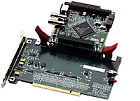 Model 623
PC/104+ to PCI Adapter
Description
Model 623 allows testing PC/104+ boards using an inexpensive desktop PC. The 623 offers significant time savings during product development and production testing by allowing PC/104+ boards to be hot-swapped within a desktop PC.
There is no need for an expensive PC/104+ enclosure and processor to test PC/104+ boards.
Protects computer
Use of the 623 protects the system’s PCI slot from physical wear and reduces the system’s electrical stress from frequent power cycling.
Model 623
PC/104+ to PCI Adapter
Description
Model 623 allows testing PC/104+ boards using an inexpensive desktop PC. The 623 offers significant time savings during product development and production testing by allowing PC/104+ boards to be hot-swapped within a desktop PC.
There is no need for an expensive PC/104+ enclosure and processor to test PC/104+ boards.
Protects computer
Use of the 623 protects the system’s PCI slot from physical wear and reduces the system’s electrical stress from frequent power cycling.
 Model 627
Compact PCI to PCI Adapter
Model 627 allows testing CompactPCI boards using an inexpensive desktop PC. The 627 offers significant time savings during product development and production testing by allowing CPCI boards to be hot-swapped within a desktop PC.
There is no need for an expensive CompactPCI enclosure and processor to test CPCI boards.
Protects computer
Use of the 627 protects the system’s PCI slot from physical wear and reduces the system’s electrical stress from frequent power cycling.
Model 627
Compact PCI to PCI Adapter
Model 627 allows testing CompactPCI boards using an inexpensive desktop PC. The 627 offers significant time savings during product development and production testing by allowing CPCI boards to be hot-swapped within a desktop PC.
There is no need for an expensive CompactPCI enclosure and processor to test CPCI boards.
Protects computer
Use of the 627 protects the system’s PCI slot from physical wear and reduces the system’s electrical stress from frequent power cycling.
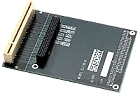 Model 327 & 328
PCI to PC/104+ Adapter
Description
Model 327 and 328 allow operating a PCI board from a PC/104+ card stack. They have the unique feature of allowing the selection of important PC/104+ signals using jumper plugs. Hence, the PCI board is not forced to use hardwired settings.
Model 327 alignes the PCI board parallel to the PC/104+ boards while Model 328 places it perpendicular.
Model 327 & 328
PCI to PC/104+ Adapter
Description
Model 327 and 328 allow operating a PCI board from a PC/104+ card stack. They have the unique feature of allowing the selection of important PC/104+ signals using jumper plugs. Hence, the PCI board is not forced to use hardwired settings.
Model 327 alignes the PCI board parallel to the PC/104+ boards while Model 328 places it perpendicular.
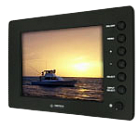 VT104XA4
10.4" Harsh Duty LCD Panel with 16.77 Million Display Colors
VarTech’s 10.4″ All-Weather, All-Terrain, Harsh-Duty LCD Display System is waterproof (fully submersible) to IP67 standards and engineered to withstand the harshest environments and most demanding real world applications.
The sunlight readable VT104XA4 is equipped with VarTech’s proprietary Enhanced Light Transmission Technology (ELTT) which allows for true Sunlight Readability and as well provides exceptional clarity and viewing angles.
This advanced user friendly LCD display system provides extensive operational temperatures of −20°C to +70°C (-4° to 158°F)(standard) or −40°C to +70°C (-40°F to +158°F)(optional) and unprecedented video input capabilities from traditional VGA to up to FOUR individual direct composite BNC video feeds with easy one-touch toggle select function between each input.
VT104XA4
10.4" Harsh Duty LCD Panel with 16.77 Million Display Colors
VarTech’s 10.4″ All-Weather, All-Terrain, Harsh-Duty LCD Display System is waterproof (fully submersible) to IP67 standards and engineered to withstand the harshest environments and most demanding real world applications.
The sunlight readable VT104XA4 is equipped with VarTech’s proprietary Enhanced Light Transmission Technology (ELTT) which allows for true Sunlight Readability and as well provides exceptional clarity and viewing angles.
This advanced user friendly LCD display system provides extensive operational temperatures of −20°C to +70°C (-4° to 158°F)(standard) or −40°C to +70°C (-40°F to +158°F)(optional) and unprecedented video input capabilities from traditional VGA to up to FOUR individual direct composite BNC video feeds with easy one-touch toggle select function between each input.
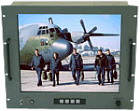 Marine / Military Series
Marine Grade Rugged LCDs
VarTech Systems manufactures a line of highly engineered rugged Marine Grade LCD Displays for the most demanding maritime environments. VarTech incorporates many features unique to the marine marketplace: ECDIS, Radar, Remote Control, Video Buffer (Multi-Drop) and Auxiliary Power Relay Output. PowerVue monitors offer continuity by design for all Navigation and Ship Automation applications. These units are suitable for a wide variety of military and commercial shipping or avionics applications where low EMI and long-term vibration resilience are essential criteria.
PowerVue series is engineered to meet application needs of your marine monitor display and military LCD flat panels. State-of-the-art PowerVue series monitors have been specifically designed to withstand the harsh maritime environment and to meet the stringent demands of IEC 60945, the international standard for Maritime Navigation and Radio Communications Equipment & Systems. Many of PowerVue monitors meet NEMA 4/4X IP65/66. Furthermore within range VarTech offer monitors having ECDIS (Electronic Chart Display Information System) and ARPA (Automatic Radar Plotting Aid) compliance.
PowerVue series includes:
VESA Mount Marine LCDs
VT190WP
VT190WP2 (Multi Scan model)
VT213WP
Rack Mount Marine LCDs
VT190RP
VT190RP2 (Multi Scan model)
VT213RP
VT231RP
Marine / Military Series
Marine Grade Rugged LCDs
VarTech Systems manufactures a line of highly engineered rugged Marine Grade LCD Displays for the most demanding maritime environments. VarTech incorporates many features unique to the marine marketplace: ECDIS, Radar, Remote Control, Video Buffer (Multi-Drop) and Auxiliary Power Relay Output. PowerVue monitors offer continuity by design for all Navigation and Ship Automation applications. These units are suitable for a wide variety of military and commercial shipping or avionics applications where low EMI and long-term vibration resilience are essential criteria.
PowerVue series is engineered to meet application needs of your marine monitor display and military LCD flat panels. State-of-the-art PowerVue series monitors have been specifically designed to withstand the harsh maritime environment and to meet the stringent demands of IEC 60945, the international standard for Maritime Navigation and Radio Communications Equipment & Systems. Many of PowerVue monitors meet NEMA 4/4X IP65/66. Furthermore within range VarTech offer monitors having ECDIS (Electronic Chart Display Information System) and ARPA (Automatic Radar Plotting Aid) compliance.
PowerVue series includes:
VESA Mount Marine LCDs
VT190WP
VT190WP2 (Multi Scan model)
VT213WP
Rack Mount Marine LCDs
VT190RP
VT190RP2 (Multi Scan model)
VT213RP
VT231RP
 CrystalVue VBOND
Sunlight Readable LCD Monitors
Reflection from sunlight destroys contrast in LCD monitors due to the gap of air that exists between the front glass and the actual LCD screen. Because of the severe difference in the consistency between glass and air, plus the fact that air actually conducts light, there are three points of high reflection in a typical LCD with the air gap.
VBOND eliminates the air-gap and in the below example has brought the reflection down from 15% to 2%. The increase in contrast ratio has gone up to 26:1 from 1.85:1. That’s and increase of 1400% in these particular conditions. This difference renders the LCD completely sunlight readable without even increasing power consumption. There are other benefits to VBOND as well.
VBOND prevents dust, moisture, and heat build up by eliminating the airgap between the glass and LCD screen.
VBOND increases protection for the LCD. Should the front glass get hit and break there will be a solid layer of protection between the glass and the LCD screen to protect scratching the liquid crystal screen. VBOND also adds structural integrity to the unit by keeping the most important pieces of the unit solidly sealed together.
Sizes 6.4” to 52”.
Mechanical configurations available: Stainless Steel Panel Mount, Panel Mount NEMA 4, Rugged Tabletop, Industrial Rack Mount, Open Frame / Chassis Mount, VESA/Yoke Mount, Large Screen 1080p and WXGA Models.
CrystalVue VBOND
Sunlight Readable LCD Monitors
Reflection from sunlight destroys contrast in LCD monitors due to the gap of air that exists between the front glass and the actual LCD screen. Because of the severe difference in the consistency between glass and air, plus the fact that air actually conducts light, there are three points of high reflection in a typical LCD with the air gap.
VBOND eliminates the air-gap and in the below example has brought the reflection down from 15% to 2%. The increase in contrast ratio has gone up to 26:1 from 1.85:1. That’s and increase of 1400% in these particular conditions. This difference renders the LCD completely sunlight readable without even increasing power consumption. There are other benefits to VBOND as well.
VBOND prevents dust, moisture, and heat build up by eliminating the airgap between the glass and LCD screen.
VBOND increases protection for the LCD. Should the front glass get hit and break there will be a solid layer of protection between the glass and the LCD screen to protect scratching the liquid crystal screen. VBOND also adds structural integrity to the unit by keeping the most important pieces of the unit solidly sealed together.
Sizes 6.4” to 52”.
Mechanical configurations available: Stainless Steel Panel Mount, Panel Mount NEMA 4, Rugged Tabletop, Industrial Rack Mount, Open Frame / Chassis Mount, VESA/Yoke Mount, Large Screen 1080p and WXGA Models.
